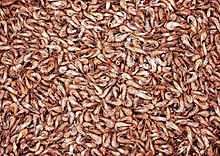Betaine
| Structural formula | ||||||||||||||||||||||
|---|---|---|---|---|---|---|---|---|---|---|---|---|---|---|---|---|---|---|---|---|---|---|

|
||||||||||||||||||||||
| General | ||||||||||||||||||||||
| Non-proprietary name | Betaine | |||||||||||||||||||||
| other names | ||||||||||||||||||||||
| Molecular formula | C 5 H 11 NO 2 | |||||||||||||||||||||
| Brief description |
dissolving, colorless crystals |
|||||||||||||||||||||
| External identifiers / databases | ||||||||||||||||||||||
|
||||||||||||||||||||||
| Drug information | ||||||||||||||||||||||
| ATC code | ||||||||||||||||||||||
| properties | ||||||||||||||||||||||
| Molar mass | 117.15 g mol −1 | |||||||||||||||||||||
| Physical state |
firmly |
|||||||||||||||||||||
| Melting point |
301 ° C (> 300 ° C decomposition) |
|||||||||||||||||||||
| solubility |
|
|||||||||||||||||||||
| safety instructions | ||||||||||||||||||||||
|
||||||||||||||||||||||
| Toxicological data | ||||||||||||||||||||||
| As far as possible and customary, SI units are used. Unless otherwise noted, the data given apply to standard conditions . | ||||||||||||||||||||||
Betaine (from Latin beta = beet, beetroot) is an oxidation product of choline . Betaine is a quaternary ammonium compound with three methyl groups and, in addition to S-adenosyl methionine, is an important methyl group donator in transmethylation processes in the organism , u. a. for the biosynthesis of creatine , methionine , lecithin and carnitine .
It is a derivative of the amino acid glycine .
Similar zwitterionic compounds are grouped under the group name betaines . Amino acids are present at the isoelectric point as zwitterions (internal salts).
Occurrence
Betaine is found in many parts of plants (broccoli, spinach) and beet sugar - molasses , as well as in mussels , extracts from crabs and in the muscles of the thorns . The name betaine is derived from the occurrence of the compound in sugar beet (Latin Beta vulgaris ). Betaine can be obtained as a by-product of sugar production. It is found in halophilic organisms that can accumulate it to limit their water loss. Betaine (the term glycine betaine is mostly used in this context) is a compatible solute from the group of zwitterionic solutes.
Betaine content in food
| product | Betaine [mg / 100 g] |
|---|---|
| Quinoa raw | 630 |
| White goosefoot | 330 |
| Beetroot , preserved, drained | 250 |
| rye | 150 |
| spinach | 100 |
| wheat | 70 |
| sweet potato | 35 |
| beef | 15-35 |
| Chicken liver | 15th |
| Mushrooms | 10 |
Manufacturing
Betaine is by means of extraction obtained from beet molasses. It can also be obtained synthetically through the nucleophilic substitution of chloroacetic acid with trimethylamine . Worldwide there are two crystallization plants for production. A third system is to be built in Tulln on the Danube from 2019.
use
Betaine is used in cosmetic products as a mild surfactant .
Health related use
Together with the vitamins folic acid , vitamin B6 and vitamin B12 , betaine is said to be able to lower high homocysteine levels in the human blood. This is considered protective against arteriosclerosis and its secondary diseases such as hypertension, PAOD, heart attack, apoplexy. The improvement in the condition of overt fatty liver is to be regarded as unsecured, since clinical studies are only available on rats and on humans on ten selected people.
Betaine is used medicinally to support the treatment of the rare homocystinuria , a congenital metabolic disorder.
In a study on cyclists, a daily intake of 2.5 g betaine led to an average increase in performance of 3.3%.
Trade names
Betaine is commercially available in Germany as a finished medicinal product under the name Cystadane ® .
Individual evidence
- ↑ Entry on BETAINE in the CosIng database of the EU Commission, accessed on December 28, 2019.
- ↑ a b c d Entry on betaine. In: Römpp Online . Georg Thieme Verlag, accessed on June 3, 2014.
- ↑ a b Entry on betaine in the GESTIS substance database of the IFA , accessed on December 19, 2019 (JavaScript required)
- ↑ a b Entry on betaine in the ChemIDplus database of the United States National Library of Medicine (NLM)
- ↑ glycine betaine at Chemgapedia
- ↑ USDA National Nutrient Database for Standard Reference Release 28
- ↑ AGRANA is building a new system for EUR 40 million on ORF on April 9, 2019, accessed on April 11, 2019.
- ↑ Marina Bährle-Rapp: Springer Lexicon Cosmetics and Body Care . Springer-Verlag, 2012, ISBN 978-3-642-24688-3 , p. 569 ( limited preview in Google Book search).
- ↑ Summary of the EMEA for Cystadane (PDF; 188 kB)
- ^ Review of the Medical Center of the University of Maryland / Baltimore , 4/1/2002
- ↑ JL Pryor, S. AS Craig, T. Swensen: Effect of betaine supplementation on cycling sprint performance in J. Int. Soc. Sports Nutrition 9 (2012) 12, doi : 10.1186 / 1550-2783-9-12 .
- ↑ Red List online, as of September 2009

